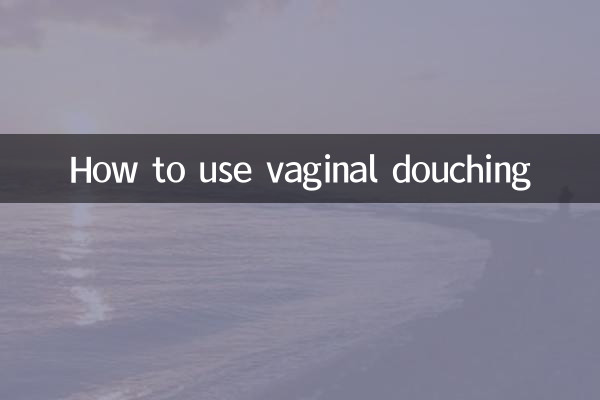Among the hot topics on the Internet in the past 10 days, content related to health and female care has continued to receive widespread attention. Among them, vaginal health issues have become one of the focuses of discussion. This article will focus onHow to use vaginal douchingThis topic combines the latest medical opinions and hot topic feedback to provide you with structured answers.
Basic concepts of vaginal douching
Vaginal douching is a way of cleaning the vagina, but in recent years the medical community has become more cautious about it. The following are the core views on vaginal douching discussed throughout the Internet:

| project | data/opinion | source |
|---|---|---|
| Support flush ratio | Only 12% of gynecologists recommend regular douching | 2023 Women’s Health White Paper |
| Opposition flush ratio | 78% of experts believe that it may damage the microecological balance | international association of gynecology |
| Hot search keywords | Search volume for "Dangers of vaginal douching" increased by 47% | A certain search engine data |
| Discussion hot spots | Lactobacillus flushing liquid becomes the new focus of controversy | social media topics |
The correct way to use vaginal douching
If vaginal douching is indeed necessary, here are the recommendations shared by medical experts on social media in the past 10 days:
1.frequency control: Most doctors recommend no more than 2 times a month. Doctor’s advice is required in special circumstances.
2.Solution selection: Warm water or medical saline is the safest choice. Avoid products containing irritating ingredients.
3.Operational points:
- Irrigators need to be strictly disinfected
- Water temperature is controlled at 35-37℃
- The pressure should not be too high
4.Time selection: Before and after menstruation, after sexual intercourse and other special periods, you need to consult a doctor whether to rinse.
Topics related to vaginal douching that are hotly discussed on the Internet
In the past 10 days, the following sub-topics have triggered a lot of discussion:
| Hot topics | Discussion popularity | Main point |
|---|---|---|
| The relationship between vaginal douching and gynecological diseases | ★★★★☆ | Excessive flushing may increase inflammation risk |
| Private parts care product reviews | ★★★☆☆ | The safety of many internet celebrity products has been questioned |
| Differences in care for different age groups | ★★☆☆☆ | Teenagers and menopausal women have different needs |
| Flushing alternatives discussion | ★★★★★ | Vulva cleaning is more recommended by experts |
The latest advice from the medical community
Based on multiple popular science articles and live broadcasts by professional doctors published within 10 days, the following suggestions are summarized:
1.Do not rinse unless necessary: The vagina has a self-cleaning function. You only need to clean the vulva with water every day.
2.Special case handling: Only consider flushing if abnormal secretions occur or if medical advice is given.
3.Product Selection Alert: Avoid using rinse products containing fragrances and preservatives
4.Pay attention to body signals: If you feel any discomfort after flushing, stop immediately and seek medical advice.
Correct common misunderstandings among netizens
Based on the analysis of recent online discussions, the following common misunderstandings are summarized:
1.Misunderstanding: "The more frequently you rinse, the healthier you will be" - Fact: May disrupt normal flora balance
2.Misunderstanding: "Douching can prevent pregnancy" - Fact: Has no contraceptive effect at all
3.Misunderstanding: "All women are suitable for douching" - Fact: Pregnant women and other special groups need special attention
In summary, the use of vaginal douching needs to be treated with caution. In recent hot discussions on the Internet, more and more voices are leaning towards the view of "less flushing and more emphasis on daily care". It is recommended that female friends consult professional doctors before making relevant decisions and choose appropriate care methods based on individual circumstances.

check the details

check the details